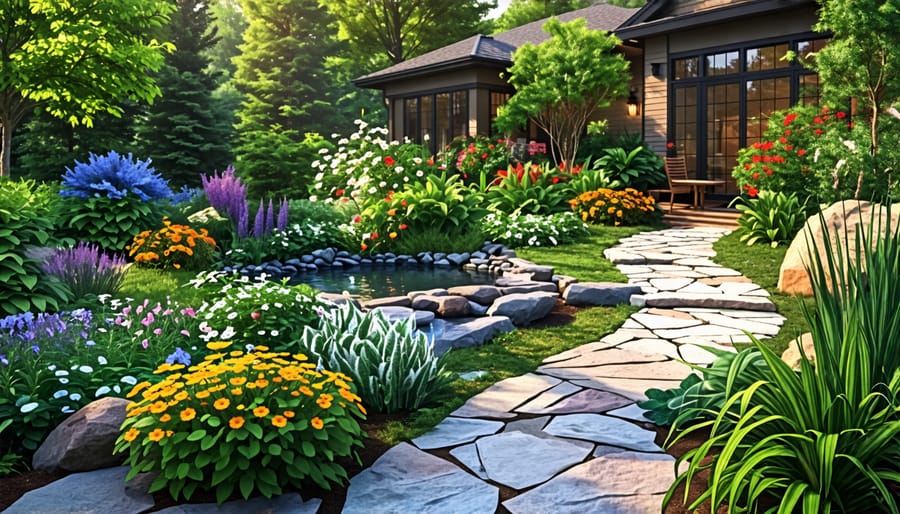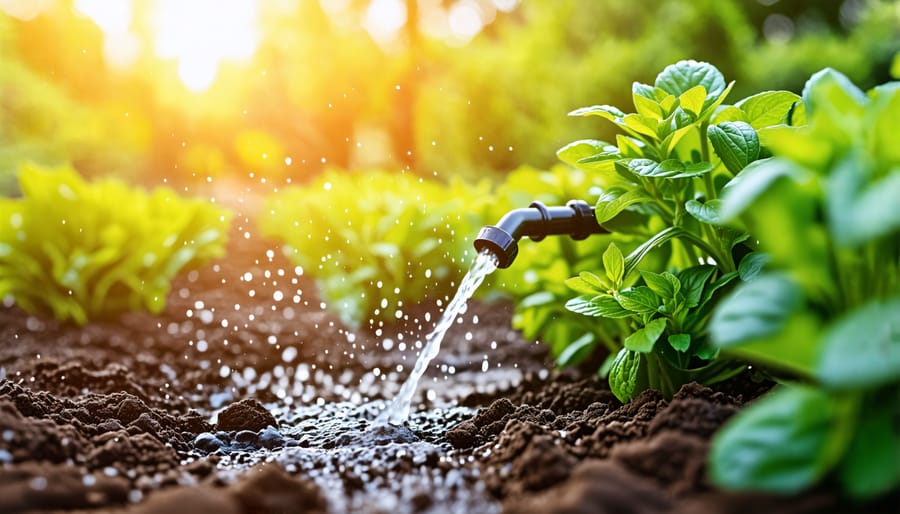Embrace sustainable landscaping to create an eco-friendly, thriving outdoor space. Choose native plants adapted to your local climate to minimize water usage and promote biodiversity. Implement efficient irrigation systems like drip irrigation or rainwater harvesting to conserve water. Incorporate organic mulch, compost, and natural pest control methods to nourish your soil and plants while reducing reliance on harmful chemicals. By adopting these sustainable practices, you’ll not only create a beautiful, low-maintenance landscape but also contribute to a greener environment, just like these inspiring examples of urban sustainable home design.
Principles of Sustainable Landscaping

Conserving Water
Conserving water is a key aspect of sustainable landscaping. To minimize water usage, consider installing a drip irrigation system that delivers water directly to plant roots, reducing evaporation and waste. Grouping plants with similar water needs together, known as hydrozoning, also helps optimize irrigation efficiency. Choosing native and drought-tolerant plants adapted to your local climate can significantly reduce the need for supplemental watering. Additionally, using organic mulch around plants helps retain soil moisture, suppresses water-hungry weeds, and moderates soil temperature. By implementing these water-wise techniques, you can create a beautiful, thriving landscape while conserving our precious water resources.
Reducing Chemical Inputs
To minimize chemical inputs in your sustainable landscape, opt for organic fertilizers like compost, bone meal, or fish emulsion. These release nutrients slowly and improve soil health. Prevent pests and diseases naturally by choosing native, disease-resistant plants and promoting beneficial insects. Mulching suppresses weeds, reducing the need for herbicides. When intervention is necessary, use targeted, low-toxicity products like insecticidal soaps or horticultural oils. Regularly monitor your landscape to catch issues early and address them with the least toxic methods. By taking a proactive, eco-friendly approach, you can maintain a beautiful, thriving yard while minimizing reliance on harsh chemicals.
Promoting Biodiversity
Using native plants in your sustainable landscape supports local ecosystems by providing food and habitat for indigenous wildlife. Native species are well-adapted to your region’s climate and soil, requiring less water, fertilizer, and maintenance than non-native varieties. By selecting a diverse array of native plants, you create a beautiful, thriving landscape that attracts pollinators, beneficial insects, and birds. Embrace the beauty and resilience of native flora to promote biodiversity in your own backyard.
Energy-Efficient Design
Thoughtful landscape design can significantly reduce home energy use. Strategically placing shade trees near your house can block the sun’s rays and keep your home cooler in the summer, reducing the need for air conditioning. Planting windbreaks on the north and northwest sides of your property can shield your home from chilly winter winds, helping to minimize heating costs. Incorporating green roofs or living walls can also provide an extra layer of insulation, further boosting energy efficiency.
Key Elements of a Sustainable Landscape
Native and Climate-Adapted Plants
Sustainable landscaping involves selecting plants that are native to your region or well-adapted to its climate. These hardy species have evolved to thrive in local conditions, requiring less water, fertilizer, and pesticides than non-native varieties. By choosing native and climate-adapted plants, you can create a low-maintenance landscape that supports biodiversity and conserves resources. Consider factors like sun exposure, soil type, and moisture levels when selecting species for your yard. Consult local nurseries, extension offices, or native plant societies for guidance on the best choices for your area. With careful plant selection, you can cultivate a beautiful, sustainable landscape that works in harmony with nature.

Efficient Irrigation Systems
Efficient irrigation systems are a key component of sustainable landscaping, helping to conserve water while keeping your plants healthy. Drip irrigation delivers water directly to plant roots, minimizing evaporation and runoff. Rain sensors automatically shut off sprinklers during rainfall, preventing overwatering and waste. Smart controllers take it a step further, adjusting watering schedules based on weather data and soil moisture levels. By upgrading to these water-wise technologies, you can significantly reduce your outdoor water consumption without compromising the beauty of your landscape. Implementing efficient irrigation is not only good for the environment but also for your wallet, as it can lead to lower water bills over time.
Permeable Hardscapes
Permeable hardscapes, like gravel pathways and interlocking pavers, allow water to seep into the ground instead of running off. This helps reduce erosion, prevents flooding, and replenishes groundwater. By choosing these materials over solid concrete, you create a more sustainable landscape that works with nature. Permeable surfaces also filter pollutants, improving water quality. Plus, they add visual interest and texture to your yard. When installing hardscapes, consider using local, recycled, or reclaimed materials for an even more eco-friendly approach. With permeable hardscapes, you can create beautiful, functional spaces that benefit both your property and the environment.
Rainwater Harvesting Features
Rainwater harvesting is a key aspect of sustainable landscaping that helps conserve water and reduce runoff. Rain gardens are shallow depressions filled with native plants that collect and filter rainwater, allowing it to slowly seep into the ground. Bioswales are similar but are designed to channel water from a larger area, such as a parking lot or driveway. Cisterns and rain barrels can also be used to collect rainwater from rooftops for later use in irrigation. By implementing these features, homeowners can reduce their reliance on municipal water sources and create a more resilient, eco-friendly landscape.
Benefits of a Sustainable Landscape
Conserving Natural Resources
Sustainable landscaping helps conserve precious natural resources. By using native plants adapted to local conditions, you can reduce water usage and protect water quality by minimizing runoff. Techniques like composting and mulching enrich the soil, prevent erosion, and improve plant health. Creating diverse habitats with native vegetation provides food and shelter for beneficial insects, birds, and wildlife. Rainwater harvesting systems collect and store water for irrigation during dry spells. By working with nature, sustainable landscapes preserve our environment for future generations while creating beautiful, thriving outdoor spaces that require less maintenance over time.
Saving Time and Money
Sustainable landscaping not only benefits the environment but can also save you time and money in the long run. By choosing native plants that are well-adapted to your local climate, you’ll reduce the need for frequent watering, fertilizing, and maintenance. Drought-resistant species further minimize water usage, leading to lower utility bills. Composting yard waste and using organic mulch nourishes the soil naturally, eliminating the need for expensive chemical fertilizers. With thoughtful design and plant selection, eco-friendly yards require less upkeep, allowing you to spend more time enjoying your outdoor space rather than constantly tending to it. These cost-saving and time-efficient benefits make sustainable landscaping an attractive choice for many homeowners.
Enhancing Property Value and Livability
Sustainable landscaping not only benefits the environment but can also boost your property value and enhance your quality of life. By creating an inviting outdoor space that’s both eco-friendly and visually appealing, you’ll have a haven to relax, entertain, and connect with nature. Thoughtful plant selection and placement can provide shade, reducing cooling costs and making your yard more comfortable. Incorporating native plants, water features, and wildlife-friendly elements attracts birds, butterflies, and other beneficial creatures, turning your landscape into a thriving ecosystem. With sustainable practices, you’ll spend less time on maintenance and more time enjoying your beautiful, thriving outdoor oasis.
Conclusion
Implementing sustainable landscaping practices in your own yard can have a profound impact on the environment and your local ecosystem. By incorporating native plants, conserving water, and avoiding harmful chemicals, you can create a beautiful outdoor space that supports biodiversity and contributes to a healthier planet. Even small changes, like using a rain barrel or planting a pollinator garden, can make a significant difference over time.
As you plan your sustainable landscape, remember that it’s a journey rather than a destination. Start with simple steps and gradually build upon your successes. Seek out resources from local gardening clubs, cooperative extensions, and online communities to learn more about eco-friendly practices that work well in your area.
By embracing sustainable landscaping, you not only benefit the environment but also create a more resilient and low-maintenance yard that can save you time and money in the long run. Your efforts can inspire neighbors and friends to adopt similar practices, creating a ripple effect of positive change in your community. Together, we can cultivate a greener future, one garden at a time.
